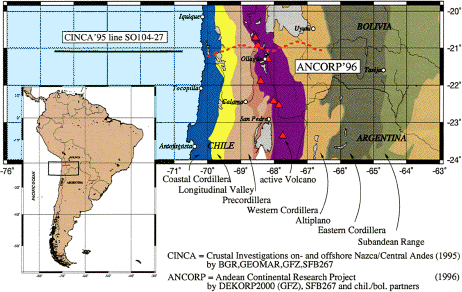The Central Andes are the type example of a cordilleran orogen related to subduction of an oceanic plate under a continental plate. They contain the second highest continental plateau in the world, the Altiplano. The magmatic arc migrated episodically more than 200 km towards the east from the Jurassic to recent times suggesting tectonic erosion at the base of the continental upper plate by the subducting oceanic plate. Neither the magmatic activity, nor the crustal shortening can fully explain the amount of thickening in the Andes. Last, not least, the Central Andes are the largest copper-, boron-, lithium-, and nitrate-anomaly of the Earth.
The aim of the ANCORP project is to seek for an integrated model for the crustal deformation in the Central Andes, considering different aspects in the different tectonic domains of the active continental margin:
- Forearc: continental erosion, mass transfer and crustal thickening; nature of deep fault zones: crustal chimneys for ascending ore-forming fluids;
- Arc: crustal structures, magma generation and ascent;
- Altiplano: nature of upper-lower plate boundary and it's relation to seismicity;formation of overthickened crust, plateau uplift and backarc dynamics;
- Basin formation in an actively deforming upper plate and their hydrocarbon potential.
The experiment complements an earlier offshore experiment (CINCA '95) that imaged the oceanic plate, the trench, and the offshore forearc. Together both experiments yield a more than 600 km long seismic section with integrated geophysical experiments (gravity, magnetotellurics, tomography) across an active continental margin (see tectonic map).
Experiments
The 400 km long seismic transect across north Chile and Bolivia comprised three components:
- a near-vertical incidence explosive-source reflection survey
- a wide-angle explosive-source survey
- three month of passive seismological recording.




